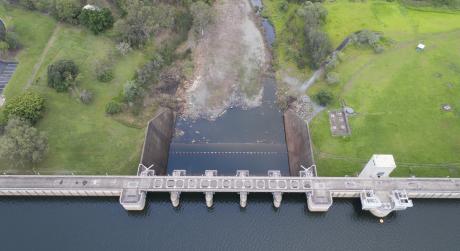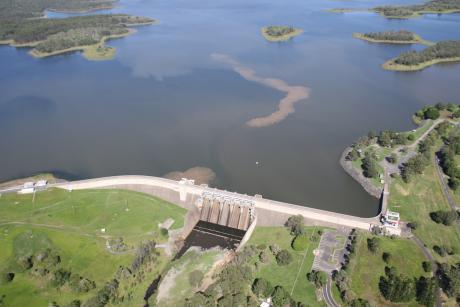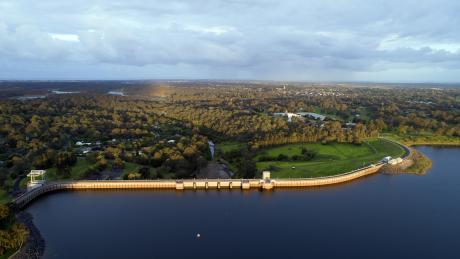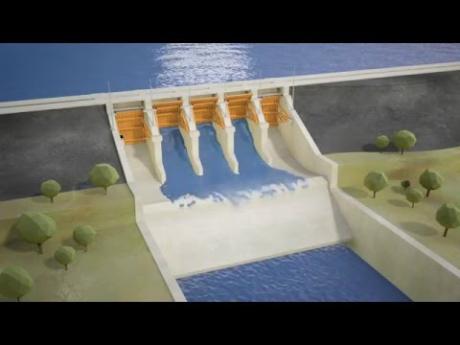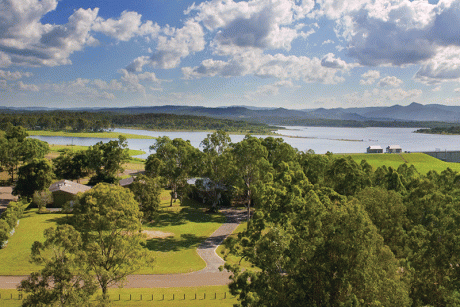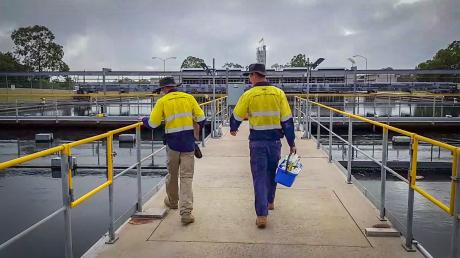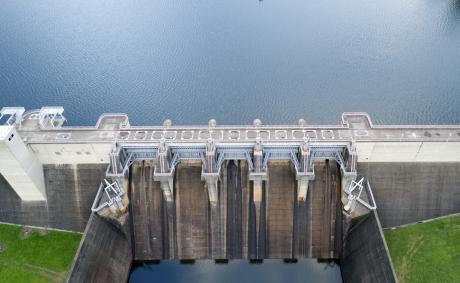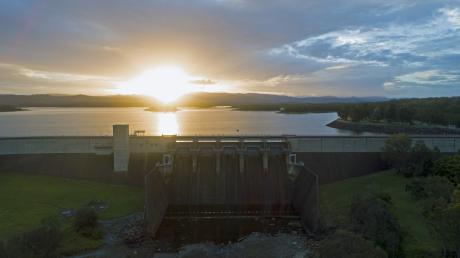
North Pine Dam Improvement Project
North Pine Dam is one of several dams to be upgraded as part of Seqwater's Dam Improvement Program.
Staged strengthening works are underway while planning continues for the main dam upgrade.
About the project
As part of our Dam Improvement Program, Seqwater is progressively upgrading dams across its network.
While our dams continue to operate safely, many of these dams were built some decades ago. These improvements are about ensuring our dams continue to operate safely into the future, including during extreme weather events, complying with modern engineering standards and safety requirements as outlined in the Water Supply (Safety and Reliability) Act 2008.
Geotechnical investigations were completed in 2024 at North Pine Dam to better understand the existing structural properties and strength of the ground conditions below the dam to inform and assist with upgrade planning.
Construction fact sheets
Seqwater is proud to partner with SRG Global Civil Pty Ltd as the major construction contractor for the Staged Strengthening project.
We acknowledge construction may cause disruption, and we appreciate the community's patience and understanding as we work together to enhance our region's water infrastructure.
Reduced full supply level
While the Dam Improvement Program is underway, North Pine Dam is operating with a reduced full supply level.
This is an industry-accepted practice to manage dam safety and demonstrates commitment to the ongoing safety of dam infrastructure.
South East Queensland has a safe, reliable, and resilient water supply system, stemming from careful and ongoing water security planning and a diverse asset base which allows Seqwater to supplement supply in a timely way when needed.
The reduced level does not significantly impact the long-term water supply security for the region.
Periodic reviews will continue until the dam is upgraded to ensure dam safety, water supply and long-term water security are appropriately managed.
Contact the team
If you have any questions about the project, please see the project FAQs below, or get in contact with the project team.
- Phone us 07 3432 7000 (during business hours)
- Email us [email protected]
- Complete the Online feedback form
Stay informed with project updates as this project progresses, by signing up to the newsletter subscription below.
Staged Strengthening Project
Construction has commenced on the Staged Strengthening project at North Pine Dam to deliver enhanced safety benefits ahead of further structural upgrades being assessed as part of the North Pine Dam Improvement Project.
The construction contract was awarded in May 2025 to SRG Global Civil Pty Ltd and the work is expected to be complete by late 2026.
The Staged Strengthening project will involve installing post-tensioned anchors vertically through sections of the dam wall and into the rock foundation below the dam. Post tensioned anchoring is an industry-accepted strategy to enhance the structural stability of dams and will ensure the dam can withstand more extreme floods, should this occur prior to the long-term upgrade.

North Pine Dam Improvement Project
Separate to the Staged Strengthening Project, Seqwater is continuing planning to carefully assess the long-term improvement options for North Pine Dam.
The Options Analysis for the North Pine Dam Improvement Project was completed in early 2025. The Options Analysis confirmed the preferred design option will include raising the dam wall, raising the saddle dams, and upgrading the spillway and gates.
The project has progressed to the next phase of planning with a Detailed Business Case focusing on developing an effective delivery plan for the upgrade to allow the dam to continue to operate safely and support our water security objectives now and into the future.
Major dam upgrades have complex design and approvals requirements and can take some years to plan and complete. Further planning will be required for the main dam upgrade project to identify the best option that meets project objectives, regulatory requirements and delivers value for money.
Seqwater is committed to keeping the community informed as these projects progress.

- project updates
- FAQs
- Resources
-
North Pine Dam Projects - Community Engagement Summary - September 2025
23 Sep 2025
Community engagement for the North Pine Dam Improvement Project commenced in June 2025 and the community was invited to participate in engagement activities to learn more about the project and have their say. Click here to view the full engagement summary.
North Pine Dam Staged Strengthening Project - Start of construction letter - September 2025
4 Sep 2025
Construction has commenced on the Staged Strengthening project at North Pine Dam to deliver enhanced safety benefits ahead of further structural upgrades being assessed as part of the North Pine Dam Improvement Project.
The construction contract was awarded in May 2025 to SRG Global Civil Pty Ltd and the work is expected to be complete by late 2026.You can view the start of construction letter here.
North Pine Dam – Q2 Community Newsletter – June 2025
6 Jun 2025
Click here to read the latest project update.
Contractor anchored for the first stage of the North Pine Dam Improvement Project
29 May 2025
Seqwater has awarded a contractor to deliver enhanced safety benefits at North Pine Dam to prepare the dam for a major upgrade to ensure ongoing safety and water security for years to come.
SRG Global Civil Pty Ltd has been selected to deliver initial strengthening works on North Pine Dam from mid-2025, as part of a more than $69 million investment into the first stage of improvement works on the dam.
Work includes installing more than 50 post-tensioned anchors into the monoliths which form part of the dam wall, ranging from 42-102 metres in length. The anchors will add around 75,000 tonnes of effective weight into the dam wall to further strengthen the structure. The works will support approximately 50 jobs on-site.
Seqwater Executive General Manager Infrastructure, Planning and Capital Delivery, Sarah Dixon, said the strengthening works will prepare the dam for majors works and ensure it continues to operate safely and provide water security for generations to come.
“North Pine Dam plays an important role in the SEQ Water Grid and supplies drinking water for the people of north Brisbane and Moreton Bay,” said Ms Dixon.
“While North Pine Dam continues to operate safely under normal conditions, the North Pine Dam Improvement Project will ensure the dam meets modern engineering and design standards.
“The strengthening works commencing this year will deliver enhanced safety benefits and prepare the dam for its major upgrade in the future,” she said.
The strengthening works are expected to commence in mid-2025 and be completed in 2027, weather and construction conditions permitting.
A Detailed Business Case is underway for the North Pine Dam Improvement Project to inform the design of the planned upgrade. This will be the first significant upgrade on the dam since its original construction in 1976.
Seqwater is committed to keeping the community informed about the project and will be hosting regular community information sessions to provide further details about the upcoming works.
To stay up to date, visit the Seqwater website.
To connect with a member of the project team, email [email protected] or call 07 3432 7000 (during business hours).
Major step towards dam big upgrades in South East Queensland
17 Mar 2025
- AECOM awarded engineering services contract to support South East Queensland dam infrastructure projects
- Seqwater’s Dam Improvement Program will ensure ongoing dam safety and water security for the region
- Major step towards progressing Somerset, Wivenhoe and North Pine Dam upgrades
Last month, Seqwater awarded AECOM a major contract to deliver engineering consultancy services on its Dam Improvement Program and other dam infrastructure projects planned to be completed by Seqwater now and into the future.
Seqwater’s Dam Improvement Program is upgrading several dams in south-east Queensland (SEQ) to ensure they continue to operate safely and provide water security for generations to come.
Seqwater CEO, Emma Thomas, said while dams in our region were built to high safety standards of the time and remain safe, dam design and engineering has evolved significantly since.
“Through Seqwater’s Dam Improvement Program, we’re investing in the longevity of our region’s dams to ensure they meet updated regulatory requirements and provide water security and flood mitigation benefits for generations to come,” Ms Thomas said.
“Seqwater has appointed AECOM as its dams engineering service provider to progress major works as part of this program including the next tranche of upgrades on the region’s gated dams – Wivenhoe, Somerset and North Pine.
“The Dam Improvement Program is an enormous undertaking. These projects are extremely complex and require extensive planning and technical expertise to ensure these major investments deliver strategic outcomes vital to the livelihoods of South East Queenslanders.
“AECOM’s industry-leading expertise will support Seqwater to deliver efficiencies across our dam infrastructure projects, meet regulatory requirements and ensure long-term safety, water security and value for money for customers,” she said.
AECOM is supporting Seqwater on key technical planning and design activities to finalise the Detailed Business Case (DBC) for the Somerset Dam Improvement Project. They will also support on the DBC for the North Pine Dam Improvement Project and the Options Analysis (OA) for the Wivenhoe Dam upgrade.
Chief Executive of AECOM’s global Water business, Beverley Stinson, said together with Seqwater, AECOM is committed to ensuring South East Queensland’s dams can continue to withstand extreme weather events.
“Our teams are committed to ensuring the ongoing safety, resilience, and reliability of Queensland’s water supply systems using the full depth of our global capabilities, and we look forward to supporting Seqwater’s vision for a sustainable future and ensuring the communities we serve have access to clean, safe drinking water for generations to come,” she said.
AECOM’s Chief Executive of the Australia and New Zealand region, Mark McManamny, said they are excited to continue our trusted partnership with Seqwater, a leader in delivering sustainable and innovative water solutions for South East Queensland.
"Our long-standing relationship with Seqwater has been pivotal in advancing other critical infrastructure projects for the bulk water supply authority, including for Hinze Dam and the Lake Macdonald Dam Improvement Project,” he said.
Enabling works are expected to commence on-site at Somerset Dam in 2025 as part of the first stage of its upgrade. Staged strengthening works are also commencing at North Pine Dam this year to deliver enhanced safety benefits ahead of the major upgrade, and geotechnical investigations to inform the Wivenhoe Dam OA concluded late 2024.
Seqwater is delivering on its largest-ever capital works program. Visit the Seqwater website for further information on the pipeline of projects and future opportunities.
Community consultation update
30 Jan 2025
Community engagement for the North Pine Dam Improvement Project commenced on 15 July 2024 and the community was invited to participate in engagement activities to learn more about the project and have their say. Click here to view the full engagement summary.
North Pine Dam - Q1 Community Newsletter - January 2025
30 Jan 2025
Click here to read the latest project update.
North Pine Dam lake level to be lowered ahead of dam upgrade
29 Jan 2025
From late-January, Seqwater will begin gradually lowering the level of North Pine Dam (Lake Samsonvale) by approximately two metres.
Over $69 million of staged strengthening works are set to begin later this year, with the lake drawdown and dam wall reinforcement all part of delivering enhanced safety benefits at North Pine Dam ahead of the main dam upgrade.
Seqwater Executive General Manager of Operations, Fiore Zulli, said releases to lower the dam from 36 metres AHD to 34 metres AHD would be done at a low-flow rate to minimise community and environmental impacts.
“North Pine Dam has been operating at a reduced supply level of approximately 68 per cent capacity since 2019 and while it continues to operate safely under normal conditions, we’re taking further precautionary measures this wet season by lowering the lake to about 54 per cent capacity to manage existing infrastructure during large inflows,” Mr Zulli said.

Low flow releases will be made from North Pine Dam's cone valve “The drawdown will have no impact on the region’s water security, as North Pine is one of several drinking water supply dams connected to the SEQ Water Grid and our combined dam levels remain high.
“We will be carefully controlling these releases, adjusting them as needed in consideration of weather events and downstream flows.”
The lower lake level of 34 metres AHD will be maintained until the staged strengthening project is completed, after which the lake level will be regularly reviewed while planning continues for the main dam upgrade.
Temporarily lowering water levels is industry standard to manage dam structures while upgrades are planned.
The lake level will be comparable to that seen in dry periods in recent years, and Seqwater will take measures to ensure boating and fishing can continue safely.
While picnic areas and recreational facilities are expected to remain open, visitors are encouraged to plan ahead for the changed water levels and check the Seqwater website or download the Seqwater app for the latest information prior to visiting.
Further project information:
The combined upgrades to North Pine Dam will be the site’s most significant investment since it was constructed in 1976 and will ensure the dam continues to meet the latest engineering standards to provide water security for years to come.
For more Information about the North Pine Dam Improvement Project, click here.
Further lake lowering information:
For more information about the dam, including the lake lowering, visit the click here.
Community info sessions begin for North Pine Dam Improvement Project
16 Jul 2024
Seqwater has announced early strengthening works to the dam wall ahead of further structural upgrades being assessed as part of the North Pine Dam Improvement Project.
Part of Seqwater’s Dam Improvement Program, the upgrade will enhance water security and enable the dam to withstand extreme weather events.
Seqwater is committed to keeping the community informed and has planned drop-in community information sessions to provide the opportunity to seek further information on either the North Pine Dam Improvement Project or Staged Strengthening works.
Drop by anytime during the sessions to speak with the team:
- Tuesday 23 July, 2.30pm - 5pm: Marketplace Warner Shopping Centre
- Saturday 27 July, 9am-12noon: McGavin View Park
- Thursday 1 August, 4pm-7pm: Marketplace Warner Shopping Centre
- Sunday 4 August, 9am-1pm: Old Petrie Town Sunday Market.
North Pine Dam – Community Newsletter – July 2024
15 Jul 2024
Click here to read the latest project update.
-
No FAQs match your query
Is North Pine Dam safe?All Seqwater dams within the Dam Improvement Program continue to operate safely.
Seqwater undertakes regular monitoring and engineering assessments to ensure all our dams continue to operate safely.
This upgrade is about ensuring the long-term viability of this important asset for the region.
Seqwater is taking further precautionary action to enhance safety at North Pine Dam during the wet season by lowering the lake to manage large spill events and catchment inflows.
Why deliver Staged Strengthening if it’s safe?North Pine Dam continues to operate safely. The dam is regularly inspected, is in good condition, and continues to operate normally.
The existing dam can withstand rare and extreme floods including possible inflows much greater than the January 2011 flood. However, with a large population living downstream of North Pine Dam, it's important we take measures to ensure the dam’s ongoing safety into the future, including against the largest possible flood we can estimate which has evolved since the dam was built.
Strengthening the dam wall will allow the dam greater capacity to withstand the Probable Maximum Flood (PMF).
While planning is underway for a major dam upgrade at this site, this innovative solution will deliver safety benefits sooner.
What is the cost of the North Pine Dam Staged Strengthening project?The North Pine Dam Staged Strengthening is a $69.6M project to deliver enhanced dam safety benefits.
What is being done about Youngs Crossing?Seqwater recognises that releases from North Pine Dam during flood events can inundate or prolong the closure of Youngs Crossing, which can cause significant disruption for the local community.
We appreciate the community’s patience when we do need to release water in accordance with the Manual of Operational Procedures for Flood Mitigation at North Pine Dam during weather events.
City of Moreton Bay is working to upgrade Youngs Crossing where it crosses the North Pine River. To find out more information about Youngs Crossing Upgrade visit www.moretonbay.qld.gov.au/Services/Projects/Roads/Youngs-Crossing
Seqwater will continue to liaise with City of Moreton Bay regarding Youngs Crossing during the dam improvement project, and when releases from North Pine Dam need to occur. The Manual of Operational Procedures for Flood Mitigation at North Pine Dam will also be updated as required throughout the dam improvement project.
Note: Outflows from Sideling Creek Dam have the ability to inundate Young Crossing without flood releases from North Pine Dam.
Why is the dam operating at a Reduced Full Supply (RFS) Level?Lowering the water level in a dam reduces water pressure and loads on the dam wall, allows safe personnel access to areas that are normally underwater, and can also create a buffer to mitigate inflows and reduce flows over the spillway during construction.
Lowering North Pine Dam's full supply level until the upgrades are completed is a precautionary measure, which will help reduce the safety risks associated with rare and extreme flood events, beyond which the dam has experienced to date.This is an industry-accepted practice to manage dam safety and demonstrates commitment to the ongoing safety of dam infrastructure.
On 28 January 2025, Seqwater enacted a Reduced Full Supply Level for North Pine Dam following further assessments of the potential safety risks associated with rare and extreme flood events. The new level equates to a storage percentage of approximately 34m AHD or 54% capacity. This new level will remain in place until dam improvement work is completed on North Pine Dam.
North Pine Dam is in good structural condition and continues to safely operate.Will the RFS Level impact water security?At full supply, North Pine Dam represents approximately 10% of the total South East Queensland Water Grid.
SEQ has a safe, reliable and resilient water supply system, stemming from careful and ongoing water security planning and a diverse asset base which allows Seqwater to supplement supply in a timely way when needed.
The temporary reduced level does not significantly impact the long-term water supply security for the region.
How does North Pine Dam affect flood mitigation in the area?North Pine Dam is operated primarily to provide water supply for residents of South East Queensland.
The original purpose of the dam did not extend to mitigation of flooding in the Pine River. There is limited storage capacity above the Operational Full Supply Level for the temporary storage of the flood water to pass floods to protect the safety of the dam.
The level of flood mitigation is influenced by several factors including inflows from the catchment, the design capacity of the flood compartment and the additional spare capacity in the dam.
Investigations determined that North Pine Dam has limited potential to improve flood mitigation, and flood mitigation will not form part of the design criteria for the North Pine Dam Improvement Project.
The dam continues to operate under the current Manual of Operational Procedures for Flood Mitigation at North Pine Dam Revision 12 (December 2023).
Will there be impacts to the recreation areas around Lake Samsonvale?Recreation areas are not anticipated to be impacted as part of the Staged Strengthening project.
Depending on the upgrade option for the main dam upgrade, there may be potential impacts to recreation facilities at North Pine Dam. We will engage with local residents regarding any potential impacts once more information on the broader dam upgrade is known.








